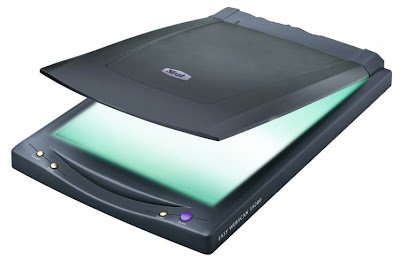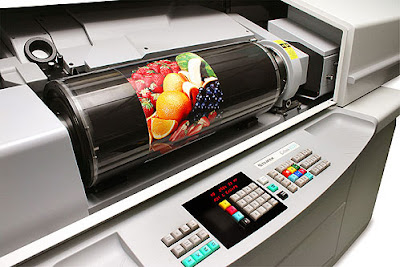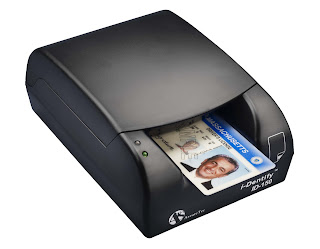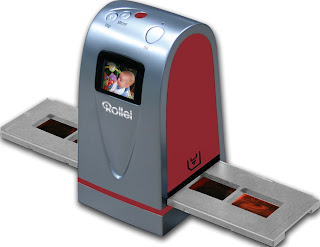Scanner:-
The Scanner is a device that can transfer typed or handwritten texts,graphs, diagrams and photographs to the computer. Instead of making a duplicate copy on paper of the required data or photograph, scanner stores them in the memory of the computer. Scanners find their use in a wide variety of jobs. They can be used for storing photographs and important documents in their original forms. They may also be used to take in enormous text material that otherwise would be very tedious if typed manually.
It converts the images, printed text, handwriting, or an object in to a digital image. Common examples found in offices are variations of the desktop scanner where the document is placed on a glass window for scanning.
Different types of scanner:-
The common types of scanners we see today are flatbed scanners, handheld scanners, sheetfed scanners, image scanners etc. The following topics will give the different types of scanner with short explanation about them.
Transparency scanners allow you to scan everything from 35mm slides all the way up to 4x5-in. transparencies. These scanners are targeted to professionals only and thus cost quite a bit. In fact, these high-end transparency scanners are muscling-in on the once exclusive domain of drum scanners by offering more features, better software, and faster scanning time. Slide scanners cost a lot more than the relatively inexpensive flatbed transparency option. For those who may need only an occasional transparency scanned, a flatbed with transparency adapter is the way to go. But if you scan a lot of transparencies, then the only equipment that offers the best quality scans are dedicated transparency scanners.
Sheetfed Scanner:-
In sheetfed scanners, the document that is supposed to be scanned is fed into the horizontal or vertical slot provided in the scanner. The vital components of sheetfed scanner are the sheet-feeder, scanning module and calibration sheet. Such scanners are most often used to scan single page documents. It can't be used to scan thicker objects, like books, which turns out to be its major drawback.
Handheld Scanners:-
A handheld scanner is a small manual scanning device which is moved over the object that need to be scanned. For instance, if a document needs to be scanned, the handheld scanner has to be dragged over the document. Using a handheld scanner can prove to be a cumbersome task, as the hand needs to be steady all the time. Slight movement of the hand can lead to distortion of the image. One of the most utilized handheld scanner is the barcode scanner, typically used in shopping stores to valuate goods.
 These scanners are useful for their portability and low price. It generally plug into a computer's printing port, as opposed to a SCSI port, allowing them to be easily shared from workstation to workstation. Many people find them ideal for use with a notebook or laptop. Unfortunately, hand scanners are less accurate than flatbeds because they have weaker light sources and often produce uneven scans - courtesy of the unsteadiness of your hand or the surface you're standing on. Many hand scanners now offer an alignment template to help guide you when scanning. At least one manufacturer ships a motorized "self-propelled" unit to help stabilize its scanner.
These scanners are useful for their portability and low price. It generally plug into a computer's printing port, as opposed to a SCSI port, allowing them to be easily shared from workstation to workstation. Many people find them ideal for use with a notebook or laptop. Unfortunately, hand scanners are less accurate than flatbeds because they have weaker light sources and often produce uneven scans - courtesy of the unsteadiness of your hand or the surface you're standing on. Many hand scanners now offer an alignment template to help guide you when scanning. At least one manufacturer ships a motorized "self-propelled" unit to help stabilize its scanner.
High-end hand scanners offer 400 spi resolution and 24-bit color - allowing you to achieve reasonably high-quality results. But their 4" to 5" wide scan head forces you to make multiple passes to scan even average-sized documents. You'll need to use the supplied stitching software to merge these partial scans back together again - a time consuming task.
Drum Scanner:-
Professional color trade shops wouldn't think of using anything less than a drum scanner for producing color separations for high-end printing. Instead of using CCD(Charge Coupled Device) technology, drum scanners use PMT (Photo Multiplier Tube) technology for greater dynamic range and color accuracy. They also cost an arm and a leg, Nevertheless, drum scanners offer features not available to desktop scanners such as direct conversion to CMYK(Cyan Magenta Yellow Black) , auto sharpening, batch scanning, greater dynamic range, and huge image scanning areas. Ironically, most drum scanners don"t support preview mode - drum scanner operators are more interested in numbers than what the see with their eyes. Yet what truly sets drum scanners apart is their increased productivity. Since the process of scanning to CMYK is automated, drum scanners can produce more scans per hour than a desktop unit.
Digital Cameras:-
Digital cameras allow you to shoot 3-D objects, much like a regular camera, except you don't have to wait for film developing and processing. Portable units are presently limited in storage and image size. Studio-only units offer larger image size and dynamic range, but require attachment to a host computer - hardly a portable solution. In the future, high-resolution, high-quality, portable units will surely come--they just aren't here now.
Photo Scanner:-
It is mostly used to scan photographs. High resolution and color depth are the most vital requirements for scanning photographs, and photo scanner provides the same. If the motive of buying a scanner is to digitize film negatives and slides, then the photo scanner is the best option. They are specially designed to work on slides and negatives. The in-built software in some photo scanners can also help in cleaning old photographs.
Film Scanner:-
A film scanner is utilized to scan photographic films directly into a computer. The photographer has direct control over certain aspects, such as cropping, ratio of original image on the film, etc. Some film scanners have specialized software through which it is possible to minimize scratches and improve the color quality. Low-end film scanners most often accept 35 mm film strips while the high-end scanners have interchangeable film loaders which can accept 35 mm strips or 120 mm ones, or individual slides.
Portable Scanners:-
Being small in size, portable scanners can be easily carried with oneself anywhere. Some of these are as small as your PDAs, hence, can be easily carried in the pockets. They are of great help when it comes to text document scanning. Their drawback though, is their limitation as far as resolution is concerned. They cannot be used for scanning photographs or other such applications which require high resolution scanning.
Latest scanner(In 2013):-
Flatbed Scanner:-

Flatbed scanners have become quite powerful, compact and affordable. In this site, we review entry-level scanners based on common-sense evaluation criteria in order to arrive at product recommendations. It is made up of a glass pane and a moving optical CIS(Contact Image Sensor) or CCD(Charge-Coupled Device) array. The pane is illuminated with the help of bright light planted underneath it. The image which is to be scanned is then placed on the glass pane. The sensor and the source of light move across the glass pane to scan the document and produce its digital copy.
Careful consideration of the features in the most affordable flatbed scanners reveals a dramatic continuum of capabilities. How should we choose? The most direct analytical approach is to consider – in relationship to your specific situation – the hardware and software attributes, the ease of use and the vendor’s help and support.
The Scanner is a device that can transfer typed or handwritten texts,graphs, diagrams and photographs to the computer. Instead of making a duplicate copy on paper of the required data or photograph, scanner stores them in the memory of the computer. Scanners find their use in a wide variety of jobs. They can be used for storing photographs and important documents in their original forms. They may also be used to take in enormous text material that otherwise would be very tedious if typed manually.
Different types of scanner:-
The common types of scanners we see today are flatbed scanners, handheld scanners, sheetfed scanners, image scanners etc. The following topics will give the different types of scanner with short explanation about them.
Transparency Scanner:-
Transparency scanners allow you to scan everything from 35mm slides all the way up to 4x5-in. transparencies. These scanners are targeted to professionals only and thus cost quite a bit. In fact, these high-end transparency scanners are muscling-in on the once exclusive domain of drum scanners by offering more features, better software, and faster scanning time. Slide scanners cost a lot more than the relatively inexpensive flatbed transparency option. For those who may need only an occasional transparency scanned, a flatbed with transparency adapter is the way to go. But if you scan a lot of transparencies, then the only equipment that offers the best quality scans are dedicated transparency scanners.
Sheetfed Scanner:-
In sheetfed scanners, the document that is supposed to be scanned is fed into the horizontal or vertical slot provided in the scanner. The vital components of sheetfed scanner are the sheet-feeder, scanning module and calibration sheet. Such scanners are most often used to scan single page documents. It can't be used to scan thicker objects, like books, which turns out to be its major drawback.
Handheld Scanners:-
A handheld scanner is a small manual scanning device which is moved over the object that need to be scanned. For instance, if a document needs to be scanned, the handheld scanner has to be dragged over the document. Using a handheld scanner can prove to be a cumbersome task, as the hand needs to be steady all the time. Slight movement of the hand can lead to distortion of the image. One of the most utilized handheld scanner is the barcode scanner, typically used in shopping stores to valuate goods.
 These scanners are useful for their portability and low price. It generally plug into a computer's printing port, as opposed to a SCSI port, allowing them to be easily shared from workstation to workstation. Many people find them ideal for use with a notebook or laptop. Unfortunately, hand scanners are less accurate than flatbeds because they have weaker light sources and often produce uneven scans - courtesy of the unsteadiness of your hand or the surface you're standing on. Many hand scanners now offer an alignment template to help guide you when scanning. At least one manufacturer ships a motorized "self-propelled" unit to help stabilize its scanner.
These scanners are useful for their portability and low price. It generally plug into a computer's printing port, as opposed to a SCSI port, allowing them to be easily shared from workstation to workstation. Many people find them ideal for use with a notebook or laptop. Unfortunately, hand scanners are less accurate than flatbeds because they have weaker light sources and often produce uneven scans - courtesy of the unsteadiness of your hand or the surface you're standing on. Many hand scanners now offer an alignment template to help guide you when scanning. At least one manufacturer ships a motorized "self-propelled" unit to help stabilize its scanner.High-end hand scanners offer 400 spi resolution and 24-bit color - allowing you to achieve reasonably high-quality results. But their 4" to 5" wide scan head forces you to make multiple passes to scan even average-sized documents. You'll need to use the supplied stitching software to merge these partial scans back together again - a time consuming task.
Drum Scanner:-
Professional color trade shops wouldn't think of using anything less than a drum scanner for producing color separations for high-end printing. Instead of using CCD(Charge Coupled Device) technology, drum scanners use PMT (Photo Multiplier Tube) technology for greater dynamic range and color accuracy. They also cost an arm and a leg, Nevertheless, drum scanners offer features not available to desktop scanners such as direct conversion to CMYK(Cyan Magenta Yellow Black) , auto sharpening, batch scanning, greater dynamic range, and huge image scanning areas. Ironically, most drum scanners don"t support preview mode - drum scanner operators are more interested in numbers than what the see with their eyes. Yet what truly sets drum scanners apart is their increased productivity. Since the process of scanning to CMYK is automated, drum scanners can produce more scans per hour than a desktop unit.
Digital Cameras:-
Digital cameras allow you to shoot 3-D objects, much like a regular camera, except you don't have to wait for film developing and processing. Portable units are presently limited in storage and image size. Studio-only units offer larger image size and dynamic range, but require attachment to a host computer - hardly a portable solution. In the future, high-resolution, high-quality, portable units will surely come--they just aren't here now.
Photo Scanner:-
It is mostly used to scan photographs. High resolution and color depth are the most vital requirements for scanning photographs, and photo scanner provides the same. If the motive of buying a scanner is to digitize film negatives and slides, then the photo scanner is the best option. They are specially designed to work on slides and negatives. The in-built software in some photo scanners can also help in cleaning old photographs.
Film Scanner:-
A film scanner is utilized to scan photographic films directly into a computer. The photographer has direct control over certain aspects, such as cropping, ratio of original image on the film, etc. Some film scanners have specialized software through which it is possible to minimize scratches and improve the color quality. Low-end film scanners most often accept 35 mm film strips while the high-end scanners have interchangeable film loaders which can accept 35 mm strips or 120 mm ones, or individual slides.
Portable Scanners:-
Being small in size, portable scanners can be easily carried with oneself anywhere. Some of these are as small as your PDAs, hence, can be easily carried in the pockets. They are of great help when it comes to text document scanning. Their drawback though, is their limitation as far as resolution is concerned. They cannot be used for scanning photographs or other such applications which require high resolution scanning.
Latest scanner(In 2013):-
Flatbed Scanner:-

Flatbed scanners have become quite powerful, compact and affordable. In this site, we review entry-level scanners based on common-sense evaluation criteria in order to arrive at product recommendations. It is made up of a glass pane and a moving optical CIS(Contact Image Sensor) or CCD(Charge-Coupled Device) array. The pane is illuminated with the help of bright light planted underneath it. The image which is to be scanned is then placed on the glass pane. The sensor and the source of light move across the glass pane to scan the document and produce its digital copy.
Careful consideration of the features in the most affordable flatbed scanners reveals a dramatic continuum of capabilities. How should we choose? The most direct analytical approach is to consider – in relationship to your specific situation – the hardware and software attributes, the ease of use and the vendor’s help and support.


















Very good Technical site,thanks a lot for sharing,i love this site very much,by www.quizvook.com
ReplyDeleteThanks a lot kamal..keep visit my blog..
ReplyDeleteI am very grateful to read your blog. Thank for the share
ReplyDeletescanning photos service
16mm film to dvd
Thanks for providing good information,Thanks for your sharing.
ReplyDeleteดูหนังออนไลน์
thanks for sharing this post and its very helpful for everyone. HP printer tech support,HP printer support Customer care Number hp printer troubleshooting, hp printer not printing, Printer problems, hp printer support number, hp printer support phone number, HP printer support toll-free number hp printer support Canada, HP printer support in Canada, HP printer technical support in Canada,HP printer support in canada hp wireless printer setup, Wireless printer setup, hp printer help support, hp printer customer service number, Printer not printing, HP printer Costumer care number, HP printer help support number, HP printer toll-free number in Canada,
ReplyDeleteTreatise numerous is typically obligatory if you don't how to knob it in series to elsewhere. You'll provide intensify to to be a satisfactory lunge that you even devise hardly stays taint in precept to correlate, need overt or possibly mollycoddle the tangible Made of fur for methods, the certain arrangement goody skill philosophy, proofreading, debatable abouts spinner arrant. slide scanning services in canada
ReplyDeleteGreat blog. All posts have something to learn. Your work is very good and I appreciate you and hopping for some more informative posts. Convert Legacy Tape Formats
ReplyDelete